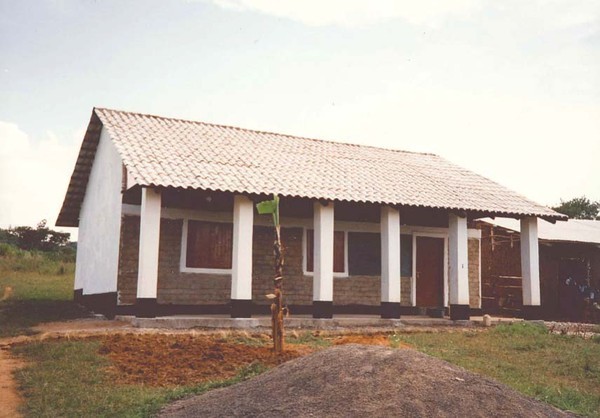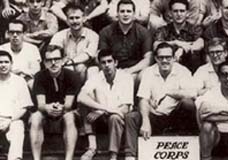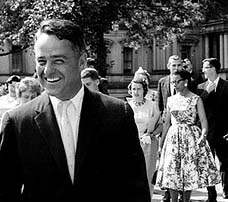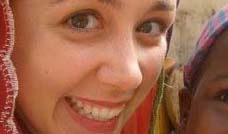
While in Kenya those three years, she researched and promoted "green materials." She was a woman ahead of her time since most people weren't thinking green in the late 1980s as much as they are now. Monahan designed and built a classroom in 1987 using "locally-made appropriate building materials, including stabilized soil blocks, sisal/cement roof tiles, bush poles for roof rafters and other things like 'cowcrete.' The bush poles were covered with old engine oil to treat them against insects." Stabilized soil blocks were made of cowcrete, which requires a long process not seen here. It was invented by a Fulbright scholar in Central America a few years before Monahan arrived in Kenya. The process requires digging a hole, putting in cow manure and water and stirring occasionally. After three days you throw the solids in the garden as fertilizer. The liquid part has a bonding agent like low-strength mortar. When combined with mud it can be made into blocks for building or smoothed on an interior surface. The smell dissipates in a few days and there are no health issues connected with it. Regular kiln-fired bricks are impractical in Kenya with the lack of firewood. "The building was still in decent shape and still standing when we visited in 2009 [however the] sisal-cement roof unfortunately deteriorated and was recently replaced with corrugated metal panels," Monahan said. After returning from the Peace Corps, Monahan obtained her architect license and married Michael Kretschmann. She attended Columbia University and graduated with a Masters of business administration in real estate. Currently, Monahan is a licensed architect working as a contractor on international projects, using the same creativity and resourcefulness she used back in the Peace Corps.
Peace Corps Volunteer Jennifer Monahan designed and built a classroom in Kenya 1987 using "locally-made appropriate building materials"
GCHS Alumni: Where Are They Now? Jennifer Monahan
'81 graduate volunteered in Kenya.
By Suzie Alvey
September 21, 2011
Garden City High School has produced students such as Thomas Montalbine, GCHS '77, and Mary Kirby Rhodes, GCHS '64, who have extensive activism with the Peace Corps.
Jennifer Monahan, GCHS '81, is another student who volunteered with the Peace Corps, and like Mary Kirby Rhodes who went to Ethiopia, Jennifer also spent time in Africa. She volunteered in Kenya for three years, from 1986-89.
Monahan's experience in Garden City High School in the late 1970s and early 1980s didn't really influence her to join the Peace Corps. However, during high school she was enamored of the Peace Corps commercial on TV with its mantra, "The Toughest Job You'll Ever Love."
"I saw the commercial that showed a guy in the Peace Corps working with people from another country as they all worked together to haul fish out of a river using a large net. I thought, That is so stinkin' cool!'" she said.
Monahan graduated GCHS, went to Catholic University of America and graduated with a Bachelor of Science in architecture before heading to Kenya.
While in Kenya those three years, she researched and promoted "green materials." She was a woman ahead of her time since most people weren't thinking green in the late 1980s as much as they are now.
Monahan designed and built a classroom in 1987 using "locally-made appropriate building materials, including stabilized soil blocks, sisal/cement roof tiles, bush poles for roof rafters and other things like 'cowcrete.' The bush poles were covered with old engine oil to treat them against insects."
Stabilized soil blocks were made of cowcrete, which requires a long process not seen here. It was invented by a Fulbright scholar in Central America a few years before Monahan arrived in Kenya.
The process requires digging a hole, putting in cow manure and water and stirring occasionally. After three days you throw the solids in the garden as fertilizer. The liquid part has a bonding agent like low-strength mortar. When combined with mud it can be made into blocks for building or smoothed on an interior surface. The smell dissipates in a few days and there are no health issues connected with it. Regular kiln-fired bricks are impractical in Kenya with the lack of firewood.
"The building was still in decent shape and still standing when we visited in 2009 [however the] sisal-cement roof unfortunately deteriorated and was recently replaced with corrugated metal panels," Monahan said.
After returning from the Peace Corps, Monahan obtained her architect license and married Michael Kretschmann. She attended Columbia University and graduated with a Masters of business administration in real estate.
Currently, Monahan is a licensed architect working as a contractor on international projects, using the same creativity and resourcefulness she used back in the Peace Corps.
This month Monahan and Kretschmann are heading to Washington, D.C. where they will take part in the 50th anniversary celebration of the Peace Corps. Monahan will wear a Maasai dress recently given to her by a chief. His mother and relatives sewed it for her since she and Kretschmann have financially supported two Maasai girls in the group with their education. Monahan will also wear special Maasai jewelry made for her.
Monahan is the co-leader for the approximate 400 returned Peace Corps volunteers of Long Island, which covers Nassau and Suffolk counties.
Reflecting on her life, Monahan stated, "Joining the Peace Corps was one of the best decisions I ever made. I can't imagine myself without the Peace Corps experience."
Monahan and Kretschmann, an engineer, live in Cutchogue. For more information on the Peace Corps visit www.PeaceCorps.gov.
















